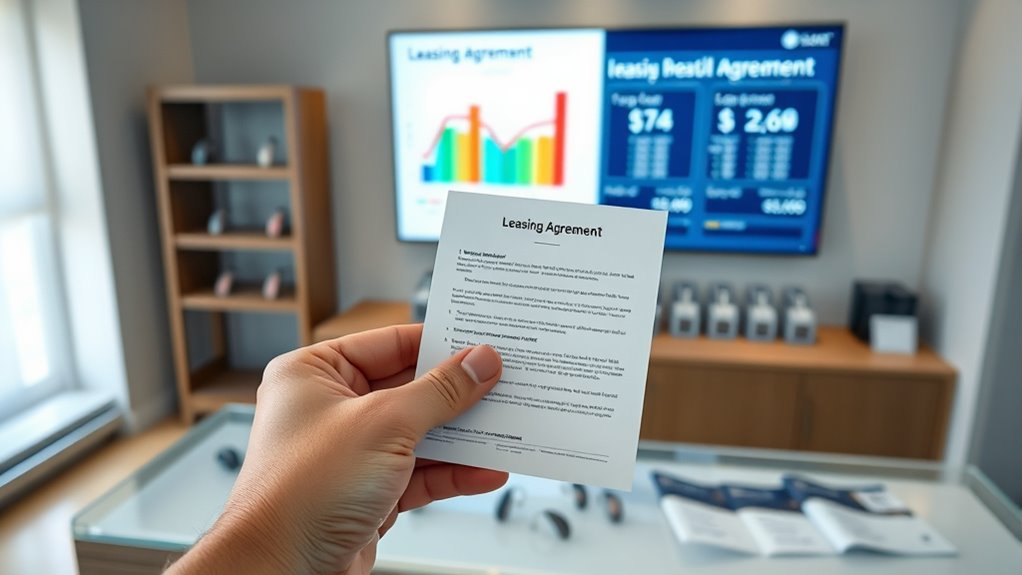Leasing hearing aids can be more affordable upfront and offer flexibility to upgrade to the latest technology without large costs. You may benefit from lower monthly payments, maintenance coverage, and options to return or upgrade easily. While long-term expenses can be manageable, watch out for hidden fees or limits on upgrades that could add costs. Exploring these factors helps you decide if leasing aligns with your financial plans, and understanding more will help you make an informed choice.
Key Takeaways
- Leasing often reduces upfront costs and provides flexible payment options compared to outright purchase.
- Regular upgrades through leasing ensure access to the latest hearing technology, potentially improving auditory health.
- Long-term expenses include monthly payments, possible maintenance fees, and early termination charges, which should be compared to buying.
- Insurance coverage can lower total leasing costs by protecting against repair or replacement expenses.
- Evaluating total costs over time helps determine if leasing offers a more economical solution than purchasing outright.
The Financial Benefits of Leasing vs. Buying

Leasing a hearing aid can often be more cost-effective than buying one outright. With leasing, you typically pay a lower monthly fee, which makes it easier to manage your budget. Insurance coverage may also help offset costs, especially if your provider offers plans that include hearing aid coverage. Additionally, leasing agreements often include options for lease termination, giving you flexibility if your needs change or if you experience issues with the device. This can save you money in the long run by avoiding costly repairs or upgrades. Unlike purchasing, leasing allows you to upgrade to newer models without a hefty upfront investment. Furthermore, understanding the sound design principles behind hearing aid technology can enhance your appreciation of the devices’ capabilities. Overall, leasing offers financial advantages through manageable payments, potential insurance support, and flexible contract options.
Upfront Costs and Long-Term Expenses

While leasing can help manage ongoing costs, it’s important to understand the initial financial obligations. You may face upfront costs such as a security deposit or initial fee, though these are often lower than buying outright. Insurance coverage can help mitigate potential damages or loss, reducing your long-term expenses. Be aware that maintenance fees might be included in your lease or billed separately; regular maintenance is essential to keep your hearing aids functioning properly. Some leasing programs cover routine repairs, but others don’t, so clarify what’s included before signing. Long-term expenses depend on factors like repair costs and whether upgrades are covered. Planning for these costs ensures you won’t be caught off guard and helps you better manage your hearing health investment. Additionally, understanding how personal growth aspects influence health decisions can empower you to make more informed choices about your hearing aid options.
Impact on Technology Access and Upgrades

Leasing hearing aids can impact your access to the latest technology and upgrades. Since leasing often includes regular upgrades, you’re more likely to stay current with advancements, reducing concerns about technological obsolescence. This model encourages brand loyalty, as providers tend to offer the newest models to retain customers. However, if you’re attached to a specific brand, leasing might limit your choices to what’s available through your provider. Upgrading to newer devices becomes seamless, ensuring you benefit from improved sound quality and features. On the flip side, some leasing agreements may restrict upgrades or charge extra for newer models. Overall, leasing can help you access cutting-edge technology regularly while fostering brand loyalty, but you’ll want to understand your lease terms to maximize these benefits. Additionally, understanding technology access can help you make more informed decisions about your hearing health options.
Potential Risks and Hidden Costs

Although leasing hearing aids can offer many benefits, it also comes with potential risks and hidden costs you should carefully consider. One key concern is the warranty terms; some leasing agreements have limited coverage or require additional fees for repairs. If your hearing aid breaks outside the warranty, you might face costly repair bills or replacement fees. Maintenance fees can also add up over time, especially if the lease includes regular check-ups or cleaning services that aren’t included in the initial payment. Additionally, hidden charges, such as early termination fees or charges for upgrades, can unexpectedly increase your costs. Before signing a lease, thoroughly review the contract to understand all warranty details and potential maintenance expenses, ensuring you avoid surprises that could outweigh the benefits. Being aware of the potential for additional charges can help you make a more informed decision.
Evaluating the Cost-Effectiveness of Leasing Programs

When considering a hearing aid leasing program, it’s important to analyze whether the ongoing costs make financial sense compared to purchasing outright. You should assess insurance coverage, which can offset monthly payments, and consider customer satisfaction, as leasing often includes updates and maintenance that improve experience. To evaluate cost-effectiveness, compare total expenses over time:
| Aspect | Benefits/Considerations |
|---|---|
| Upfront Cost | Leasing reduces initial payment but may cost more long-term |
| Insurance Coverage | Can lower monthly costs and improve affordability |
| Device Updates | Leasing often includes upgrades, boosting satisfaction |
| Total Cost Over Time | Calculate total payments vs. purchase price for clarity |
This comparison helps you determine if leasing aligns with your financial and satisfaction goals.
Frequently Asked Questions
How Do Leasing Programs Affect Overall Hearing Health Outcomes?
Leasing programs can positively impact your hearing health outcomes by improving device accessibility and encouraging regular hearing care. When you lease, you’re more likely to keep up with maintenance and upgrades, ensuring peak device performance. This ongoing access helps you detect issues early and maintain better hearing health overall. By making hearing aids more affordable and accessible, leasing programs empower you to stay proactive about your hearing care, leading to improved quality of life.
Are There Specific Demographic Groups That Benefit Most From Leasing?
You might find that certain age groups, like seniors, benefit most from leasing because they often need frequent upgrades and ongoing support. Additionally, individuals with lower income levels may prefer leasing since it offers lower upfront costs and flexibility. By choosing leasing programs, you can access advanced hearing technology without heavy initial expenses, making it a practical option especially for those who prioritize affordability and regular device updates.
What Are the Legal Rights and Protections for Leasing Participants?
You have legal protections when entering lease agreements for hearing aids. These protections guarantee you’re informed about costs, terms, and your rights. Lease agreements should clearly outline payment schedules, maintenance responsibilities, and options for buyout or cancellation. If issues arise, you can seek legal recourse or dispute resolution. Always read your lease agreement carefully, and know that laws often protect you from unfair or deceptive practices in leasing arrangements.
How Do Leasing Programs Influence Hearing Aid Innovation and Market Competition?
Leasing programs impact hearing aid innovation and market dynamics by encouraging manufacturers to develop advanced, cost-effective technological advancements that appeal to consumers seeking flexible options. As you participate in leasing, you may notice increased competition among providers, leading to better products and services. This system fosters rapid innovation, ensuring you benefit from the latest hearing aid technology, while also maintaining competitive pricing and diverse choices in the market.
What Are the Long-Term Financial Implications After Lease Term Completion?
After your lease ends, you should consider the residual value of the hearing aid, which impacts your overall costs if you decide to buy or upgrade. Maintenance costs may still apply if the device needs repairs, affecting your long-term expenses. Leasing might initially seem cheaper, but these ongoing costs and the residual value can influence whether it’s more economical than purchasing outright in the long run.
Conclusion
Ultimately, choosing between leasing and buying your hearing aids is like deciding whether to plant seeds or harvest crops—you’ll reap benefits differently. Leasing offers flexibility and access to the latest tech, but watch out for hidden costs that can grow like weeds. By weighing the long-term expenses against immediate savings, you can make a smart choice that benefits your hearing health and finances. So, which path will you take—investment or innovation? The choice is yours.










